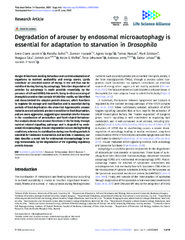Degradation of arouser by endosomal microautophagy is essential for adaptation to starvation in Drosophila
Permanent link
https://hdl.handle.net/10037/25580Date
2020-12-14Type
Journal articleTidsskriftartikkel
Peer reviewed
Author
Jacomin, Anne-Claire; Gohel, Raksha; Hussain, Zunoon; Varga, Agnes; Maruzs, Tamas; Eddison, Mark; Sica, Margaux; Jain, Ashish; Moffat, Kevin G.; Johansen, Terje; Jenny, Andreas; Juhasz, Gabor; Nezis, IoannisAbstract
Hunger drives food-seeking behaviour and controls adaptation of
organisms to nutrient availability and energy stores. Lipids
constitute an essential source of energy in the cell that can be
mobilised during fasting by autophagy. Selective degradation of
proteins by autophagy is made possible essentially by the
presence of LIR and KFERQ-like motifs. Using in silico screening of
Drosophila proteins that contain KFERQ-like motifs, we identified
and characterized the adaptor protein Arouser, which functions
to regulate fat storage and mobilisation and is essential during
periods of food deprivation. We show that hypomorphic arouser
mutants are not satiated, are more sensitive to food deprivation,
and are more aggressive, suggesting an essential role for Arouser
in the coordination of metabolism and food-related behaviour.
Our analysis shows that Arouser functions in the fat body through
nutrient-related signalling pathways and is degraded by endosomal microautophagy. Arouser degradation occurs during feeding
conditions, whereas its stabilisation during non-feeding periods is
essential for resistance to starvation and survival. In summary, our
data describe a novel role for endosomal microautophagy in energy homeostasis, by the degradation of the signalling regulatory
protein Arouser.
Publisher
Life Science AllianceCitation
Jacomin, Gohel, Hussain, Varga, Maruzs, Eddison, Sica, Jain, Moffat, Johansen, Jenny, Juhasz, Nezis. Degradation of arouser by endosomal microautophagy is essential for adaptation to starvation in Drosophila. Life Science Alliance (LSA). 2020Metadata
Show full item recordCollections
Copyright 2020 The Author(s)


 English
English norsk
norsk